Papers by christian nsiah
Supplemental Material, sageh for The African economic growth experience and tourism receipts: A t... more Supplemental Material, sageh for The African economic growth experience and tourism receipts: A threshold analysis and quantile regression approach by Herman Sahni, Christian Nsiah and Bichaka Fayissa in Tourism Economics
Supplemental Material, sagej for The African economic growth experience and tourism receipts: A t... more Supplemental Material, sagej for The African economic growth experience and tourism receipts: A threshold analysis and quantile regression approach by Herman Sahni, Christian Nsiah and Bichaka Fayissa in Tourism Economics
Supplemental Material, graph for The African economic growth experience and tourism receipts: A t... more Supplemental Material, graph for The African economic growth experience and tourism receipts: A threshold analysis and quantile regression approach by Herman Sahni, Christian Nsiah and Bichaka Fayissa in Tourism Economics
Journal of African Development, 2021
We use a panel data set of 46 African countries over the 2003–15 period to study the role of inst... more We use a panel data set of 46 African countries over the 2003–15 period to study the role of institutional quality in infrastructure-led growth. Based on the causal analysis, we show large positive effects of growth for countries with strong institutional quality in comparison to their counterparts with weak institutional quality. This result is not sensitive to the choice of a particular measure of infrastructure or institutional quality. Our results suggest the presence of nonlinearities when estimating infrastructure-led growth and emphasize the importance of complementarities influencing such an estimation.
African Development Review, 2019
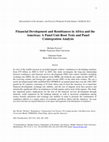
In view of the sizable increase in recorded migrant workers’ remittances to developing countries ... more In view of the sizable increase in recorded migrant workers’ remittances to developing countries from $70 billion in 2000 to $167 in 2005, this study investigates the long-run relationship between remittances and financial services development (FSD) and control variables including exchange rate (ERS), the size of migrant stock (MSK), the domestic per capita income (DPC) in the receiving country and foreign per capita income (FPC) in the main host country. We use a newly developed panel fully modified OLS (PFMOLS) on annual panel data over the 1985-2007 period for 44 countries consisting of 25 from Africa and 19 from the Americas. It is found that financial development, exchange rate stability, and the size of migrant stock have positive and statistically significant effect on remittances in both regions and in each of the regions. The study has important policy implications for the role of the financial services development through domestic credit expansion by the banking industry a...
The Oxford Handbook of Africa and Economics, 2014
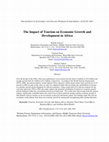
Tourism Economics, 2008
During the 1990s, Africa experienced a rise in tourist arrivals from 8.4 million to 10.6 million ... more During the 1990s, Africa experienced a rise in tourist arrivals from 8.4 million to 10.6 million and a growth in receipts from US$2.3 billion to US$3.7 billion. According to the World Tourism Organization, the tourism industry in sub-Saharan Africa enjoyed a robust annual market share growth rate of 10% in 2006. In spite of this, there are few empirical studies that investigate the contributions of tourism to the economic growth and development of African economies. Using panel data of 42 African countries for 1995 to 2004, this study explores the potential contribution of tourism to the economic growth and development within the conventional neoclassical framework. The results show that receipts from the tourism industry contribute significantly both to the current level of gross domestic product and to the economic growth of sub-Saharan African countries, as do investments in physical and human capital. The authors' findings imply that African economies could enhance their sho...
Journal of Economics and Finance, 2009
Compensating wages have been documented for a number of job attributes including working non-stan... more Compensating wages have been documented for a number of job attributes including working non-standard hours. Using data that aggregates across occupations, our analysis confirms a wage premium for working night shifts. However, the compensating wage is greater in areas where unemployment is low, suggesting that employers are less pressured to compensate for night shifts when employment opportunities are relatively scarce.

Journal of American Indian Education, 2022
Abstract:Colleges and universities have devoted considerable effort toward keeping students in sc... more Abstract:Colleges and universities have devoted considerable effort toward keeping students in school until graduation. Researchers accordingly have studied various factors that shape these retention rates, including integration into the school's culture and involvement in school activities as well as innate academic ability. Yet more studies need to specifically examine the complex mix of positive and negative influences on Native American student retention. This article evaluates some of those influences by investigating whether a strong desire for social interaction can encourage these students to succeed academically and remain in school until graduation. At one predominantly White institution lacking Native American organizations, we find that increased receptivity to social interactions by Native American students has a positive impact on grades but a negative influence on retention. We propose that schools should adopt a mix of general and culture-specific activities to e...

The number of overweight youth has more than doubled since the early 1970s. According to the Cent... more The number of overweight youth has more than doubled since the early 1970s. According to the Center for Disease Control, approximately 13 percent of children and adolescents are seriously overweight. Obesity among adolescents has been linked with behavioral and psychological problems, affecting adolescent socialization, self-esteem, and performance in all facets of life. Using data from the 1997 National Longitudinal Survey of Youth, we employ ordinary least squares, instrumental variables, and quantile regression models to investigate how being overweight can impact a youth’s education performance measured as actual credit-weighted grade point average. Overall, we find a negative relationship between being overweight and GPA. We also find that the negative relationship is more pronounced in urban areas than in rural areas. The quantile regression estimate indicates that the magnitude of the relationship between youth’s GPA and being overweight depends on the GPA quantile in question.
Community College Journal of Research and Practice, 2009
... Prathibha V. Joshi a * , Kris A. Beck a & Christian Nsiah b pages 805-822. ... Accord... more ... Prathibha V. Joshi a * , Kris A. Beck a & Christian Nsiah b pages 805-822. ... According to the American Council on Education ([ACE], 20041. American Council on Education (ACE) . ( 2004 ). Choice of institution: Changing student attendance patterns in the 1990s . Issue Brief . ...
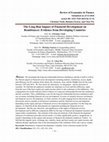
Review of Economics and Finance, 2019
We investigate the long-run relationship between remittances and the overall as well as the iffer... more We investigate the long-run relationship between remittances and the overall as well as the ifferent aspects of financial sector development including markets, institutions, access, depth, and efficiency for 85 countries from Africa, the Americas, Asia, and the Middle East for the years between 1995 and 2014. We first check for stationarity, co-integration, and the direction of causality. We find that all employed variables are stationary in levels and first difference, apart from the case of the host country per capita income which is only stationary in first difference. Our cointegration test results indicate robust evidence of a long-run relationship between the remittances and the covariates. Thus, establishing a case for the long run relationship between remtitances and our covariates including financial services development. In terms of causality between remittances and financial services development, we find a mixture of results ranging from bi-directional, unidirectional, an...
Journal of Economics and Finance, 2011
Economics Bulletin, 2016
Unions have been shown to reduce wage inequality, thus resulting in higher wages for certain disa... more Unions have been shown to reduce wage inequality, thus resulting in higher wages for certain disadvantaged groups. Overweight individuals, especially women, generally receive lower wages than thinner individuals with similar socioeconomic characteristics. This paper demonstrates that union wage protection extends to overweight women in the U.S. Specifically, obese women do not experience a wage penalty when employed in jobs covered by collective bargaining.
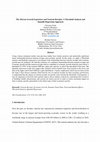
Using a linear estimation model, most previous stud ies have found a positive and statistically s... more Using a linear estimation model, most previous stud ies have found a positive and statistically signifi cant linear relationship between tourism receipts and ec onomic growth. In this study, we apply a Threshold analysis and Quantile regression to investigate if he relationship between tourism receipts and econo mic growth may be nonlinear. We find the existence of a nonlinear relationship between tourism receipts an d economic growth and that tourism receipts tend to c ontribute to economic growth relatively more below a threshold of 2.59% of the tourism/ GDP per capita r atio and less so above this threshold of the ratio. The Quantile regression results also suggest that count ries tend to benefit more from tourism at the lower end than at the upper end of their GDP per capita distr ibution. A policy implication which may be drawn fr om the study is that African countries which heavily r ely on tourism receipts for their economic growth h ave to understand that the impact of touri...
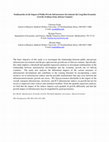
The basic objective of this study is to investigate the relationship between public and private i... more The basic objective of this study is to investigate the relationship between public and private infrastructure investments and the per capita income growth rate of African countries. Specifically, this study employs a threshold and quantile regression analysis to investigate nonlinearities in the relationship between infrastructure development and the economic growth rate of African countries. The study also analyzes the differential impacts of the various measures of infrastructure development and contributes to the existing literature by incorporating a more inclusive set of infrastructure indices and the possible nonlinearities that may exist between the infrastructure/economic growth rate nexus. We find governance thresholds in the impact of the overall, transport infrastructure, electricity, and ICT infrastructure indices on growth but not for access to improved water sources and sanitation facilities. From the quantile regression analysis, we find that the impact of the indice...

The new economic geography literature has broadened awareness that economic agents’ geographic lo... more The new economic geography literature has broadened awareness that economic agents’ geographic locations influence one another. Whereas the effect of proximity between exporting and importing units has been investigated somewhat heavily, the possible effect that neighboring economic units can have on each other’s trade with other economic units only relatively recently has received much attention. Neglecting spatial correlation can produce biased estimated coefficients and, consequently, biased estimates of trade, regardless of methodology the latter is based on. Using panel data on the manufacturing exports of the 48 contiguous U.S. states to 24 Asian countries, we empirically test for local spatial linkages in the manufacturing exports of U.S. states to the Asian region. We investigate if spatial linkages are created by geographic, cultural, infrastructural, innovation asset, business environment, and economic development proximities. We find that all proximity weights generate st...
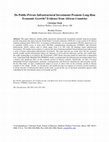
This paper addresses whether public and private infrastructure investments promote long-run econo... more This paper addresses whether public and private infrastructure investments promote long-run economic growth using panel data taken from the World Bank’s Economic Indicators (WDI) for a cross-section of 50 African countries spanning from 1995 to 2012. As measures of infrastructure, we use transportation (TRANS), improved access to sanitation (SANI), access to clean water (WATER), communication infrastructure (COMMU), and electricity infrastructure (ELEC) indices each of which ranges from 0 to 100 (with 100 denoting robust infrastructure investments). We employ factor analysis to construct the above listed uncorrelated 5 broad infrastructure indices from a series of factors representing infrastructure investments. The panel unit-root test results show that the economic growth variable and the infrastructure indices are stationary in levels and first difference and they also exhibit longrun stable relationship as revealed by the Westerlund’s (2007) Error-correction model for panel data...
We investigate both the weak and strong forms of PPP between 33 African countries, the United Sta... more We investigate both the weak and strong forms of PPP between 33 African countries, the United States, Euro area, South Africa, and Nigeria. The study applies panel unit root tests, panel cointegration tests, panel granger causality test and the panel fully modified OLS models to quarterly CPI and nominal exchange rate data for the period 1995Q1-2014Q4. We find great support for the weak form of PPP and a persistent bi-causal relationship between the nominal exchange rates and the respective price differences between the African countires and reference countries. Support for a strong form of PPP occurs, however, in the post-recession era for the U.S. dollar and the British pound. When we break the data into pre and post-recession, we find a unidirectional causality for the South African rand, pound, and euro in some cases.











Uploads
Papers by christian nsiah